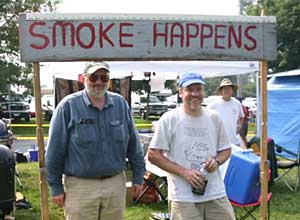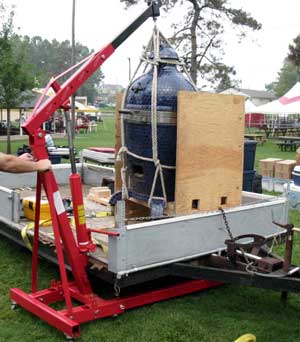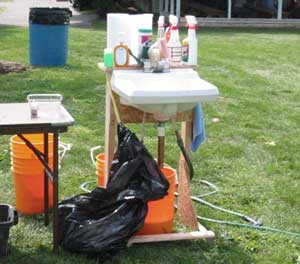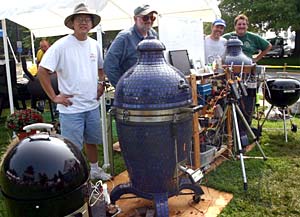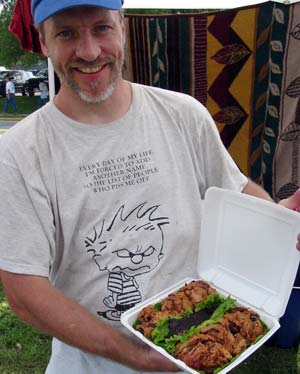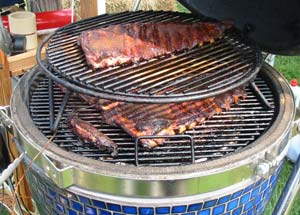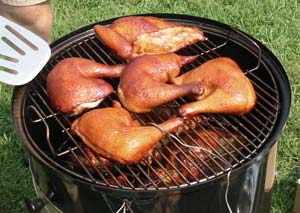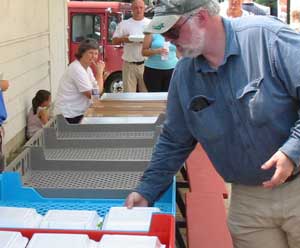![]()

The PA State BBQ Competition in New Holland The following is Jan's report (initially reported on another site): August 31, 2004 — About a year ago, a old friend of mine (Doug) and I attended a BBQ class by the legendary "Baron of BBQ" Paul Kirk. We loaded up our cookers, commuted 90 minutes and managed to start our fires before 7 am. We learned a ton and after it was all over, we were hooked to the taste of good 'Que and decided to try our hand at the competition the following year. Shortly after the class, we registered our team name "Smoke Happens" with the Kansas City BBQ Society, the official governing body of BBQ. After a year of subjecting the fellows at Project H.O.M.E., various Wanderers (the running club), dinner guests and co-workers to our creations during the last 12 months, we thought we knew what it took to compete. Well... kind of. The event was the PA State BBQ Championships, held in New Holland, Pa last August 27-28 (2004). New Holland is near Lancaster, PA set in the middle of Amish country. A total of 54 teams entered the competition. In order to compete, teams must enter the five mandatory categories: sausage, chicken, pork ribs, pork butt (shoulder), and brisket. Optionally, teams can also enter the Chef's Choice, Whole Hog competition, the prettiest Pig In The Park, and the kids competition. Before we could even consider the competition itself, we had to figure out how we were going to bring our 450-pound, top-heavy and (very) breakable Kamado cookers to the competition. The last time these cookers were transported, they were lifted onto our trailer by a freight company's forklift. Getting them down entailed the services of many friends and neighbors. Rather than taking this route again, we bought a crane and devised an elaborate shipping crate. First, we attached a 'sling' made out of a long heavy duty rope. Then we lifted the egg-shaped cooker, positioned it in the center of the trailer and then assembled the crate around it. Before we were even out of my driveway, my system was put to the test: between the 450 pound cooker, the 250 pound crane, and the 150 pound crate, the trailer scraped the hell out of the sidewalk. But it survived this first bump and we knew then that the rest of the trip would be fine. After delivering the first cooker to a 'staging area' near the site of the competition (which would save us time in the morning), we repeated the process. On Friday morning, before 6 a.m., we were headed for New Holland. It took us nearly three hours to unload our cooker, get the other cooker and unload the rest of our stuff. While I am not one to travel light, my partner in crime is unbelievable. I am not kidding when I say that we were barely able to fit all 'our' stuff into our allotted 20x20 foot space. We literally brought everything including a kitchen sink. We had many, many coolers, music, four BBQ grills, charcoal starters, canopy, bedding, many boxes of charcoal, more spices than any of you are likely to have in your kitchen cabinets, pots, pans, bowls, etc. along with many cases full of electronics, thermometers, and ligthing. We knew things were getting serious when at noon (on Friday) the official KCBS official came to perform the mandatory meat inspection. They measured the various temperatures, checked our general setup including disinfectant, sanitizer (to neutralize bleach), meat storage coolers, etc. We passed the test without a problem and as soon as we were done, we started 'rubbing' the meat with our home grown dry rubs. (these spice-mixes are called rubs as they are rubbed into the meat by hand prior to cooking). Before starting up the smokers, we devised a cooking schedule and grill space plan. One of the requirements is that cooked food is not allowed to cool down or re-heated. Since we were cooking 25 pounds of pork, 25 pounds of brisket, many sausages, three slabs of ribs, and 3 whole chickens, we needed to plan our grill space carefully. To make things more complicated, some of the foods (brisket) take up to 22 hours to cook and different foods are cooked at different temperatures. Finally, ribs and chicken both need to be finished off by cooking them briefly at a higher temperature. All six entries are to be submitted within 10 minutes of their respective turn-in times. After figuring out what meat was supposed to go onto what cooker and at what time, we started executing our plan. The brisket went on first, on Friday afternoon, then the butts later that night. We spent the rest of the day making sauces, tending to fires, etc. It didn't take long before we were surrounded in heavy clouds of smoke. We use special high-density extruded coconut charcoal which does not emit any smoke by itself. We impart the smoke flavor we do want by adding first-size chunks of wood on top on the semi-odor-free charcoal: hickory for pork, cherry for the beef, and apple for ribs. It didn't take long before people started walking past our setup snickering. By virtue of our team name ("Smoke Happens"), a kitchen sink that we plumbed to connect to a standard garden hose, and a wall of temperature measuring equipment, data loggers, laptop, lighting, battery power, inverters, etc., we were clearly the geeks in the park. My partner is an ex analytical chemist who brought just about his whole lab to the park. For those of you who are interested, the graphs of the data points of 6 or 7 therma-couple meters are posted on the web somewhere. We spent the night tending to the fires and making sure things were on schedule. Anyone can make a hot fire; making sure your fire (measured at the grill level as well as the dome) doesn't exceed 225-250 is a little trickier. With our types of cookers, this task is a lot easier but still requires work. Several times during the night, we were wakened by one of our alerts/alarms to adjust draft door openings, poke the coals, add flavor wood (for smoke), or move or turn over meat. By Sat morning, I was fried but in good spirits and things were going as planned. On Sat morning, we had a brief period of time to relax. Rather than kick back and relax, I picked this time to... pick a fight. Among the 80-some odd competitors and food vendors, there was also a booth manned by the local Republicans handing out bumper stickers, signage, and collecting donations. While some of the motorcyclists with their german helmets bothered me, at least this was a fight I could pick. So I waited for the right moment when there was a sizable group of people in line. I jumped to the front and loudly started my assault. Without getting into the details here, I accomplished my goal: people left the scene immediately leaving only the speechless RNC workers. The best they could do was give me a number to call for my questions and to express their condolences for my loss. A low blow even by my standards but these were desperate times. After a kick-ass Amish milkshake, I felt re-energized and ready for the competition. Later on Saturday morning, we put on the ribs, then the chicken, then the sausage. That's when things started getting out of control. Even though we had brought the two large Kamados, a Weber bullet (water cooker), and a regular Weber kettle, we quickly ran out of grill space. Furthermore, our sausages were cooking faster than anticipated and so did our chicken. In contrast, one of our briskets felt good but showed it was slow in coming up to it's target temperature. Amidst all this craziness we had to worry about... lettuce. I will never look at lettuce the same way again. You are only allowed to use certain types of lettuce and I went through several heads of the eligible greens to find the perfect leaves to use to line the styrofoam containers. While presentation counts for 33% of your score, you are not allowed to make any decorations. Doing so results in disqualification. To present the various entries, you have to have at least 6 identifiable pieces of the meat on a bed of the lettuce. You would be amazed how few leaves of lettuce don't have a little nick, ding, hole or some other 'problem'. When we submitted our sausage entry (the first one) we almost got disqualified for being late. We assumed that a 10 minute window meant 10 minutes after the specified time, not 5 before and 5 after. But we survived and every half an hour thereafter, we submitted our various entries. Thanks to our atomic clock, and having timed our walk to the entry table, we were comfortably in time for the remainder of the entries. After, we submitted the last entry, we all but collapsed from exhaustion. We started to speculate about our placement in the various categories. We knew we had messed up in various ways: the presentation was lacking here and there, the sausage didn't have grill marks on them, the skin on the chicken wasn't very crispy, and so on. It wasn't until the awards were announced that were learned that we were squarely placed in the back of the pack. Specifically, 44th out of 54 teams! We were very disappointed although we realized is was probably just. Clearly, if the logistics of our team bringing our 450-pound Kamado cookers to the site were taken into account, we would have swept the contest.
One of our two Kamados and a Weber Bullet along with more temperature equipment and data logging devices than can be found in most scientific laboratories. Now, a few days later, we have been able to figure out what to do better next time. There is another competition next month which we are considering entering. We plan to change our rubs and sauces and try again. Specifically, the judges tend to like sweet entries better than the spicy so we went pretty bland with our entries. We are now speculating, however, that our entries need to be a little spicier in order for them to stand out. Furthermore, rather than "pulling" the entire shoulder and mixing it with sauce, we are going to try to only submit the darker strands of the pork shoulder along with some bark for maximum flavor.
Jan Deruiter
|
